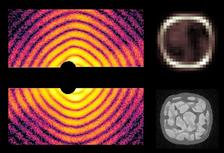Diffraction image of a hollow silver nanoparticle (left) measured at FLASH, along with its reconstruction (top right) and a corresponding picture from MD simulations (bottom right). (Credit: T. Reichenbach, Univ. Freiburg)
Matter under extreme conditions, especially at extreme temperatures and pressures, plays an important role in many fields. These range from astrophysics and geology over inertial fusion reactor studies to applied research on material processing by laser ablation. Due to the complex behaviour of matter under such conditions the underlying interactions are not yet fully understood. In recent years isolated nanoparticles, which form well-defined crystalline structures at lower temperatures, have proven to be suitable test objects for the study of such questions.
A team of researchers including DESY scientists around Daniela Rupp (ETH Zurich), Thomas Möller (TU Berlin) and Bernd v. Issendorff (Univ. Freiburg), as well as several groups from Univ. Rostock (Ingo Barke, Karl-Heinz Meiwes-Broer, Thomas Fennel), has applied time-resolved soft X-ray diffraction at the CAMP endstation at FLASH to study the dynamics of superheated silver nanoparticles in a laser pump – FEL probe experiment. They observed that silver nanoparticles, when strongly laser-heated via their plasmon resonance, exhibit a wide range of phenomena, from melting over cavitation-induced bubble-like expansion to explosion, as a function of the excitation strength. “Depending on the heating conditions and the temporal evolution, we could identify different classes of diffraction images, stemming from faceted, round, hollow, fragmenting or sometimes finally exploding nanoparticles”, Alessandro Colombo (ETH Zurich), one of the three first authors, explains.
Accompanying large-scale molecular dynamics (MD) simulations by Michael Moseler und Thomas Reichenbach (Univ. Freiburg und Fraunhofer IWM) show that cavitation and explosion are triggered by a decompression wave following near-isochoric heating. This wave induces high negative pressures within the particle that can lead to cavitation or its disintegration, depending on if and where the system crosses the so-called spinodal in the phase diagram, the boundary beyond which a superheated liquid becomes unstable.
This first-of-its-kind experiment published in Physical Review Letters opens a new avenue for studying superheated material in regions of the phase diagram that are otherwise difficult to access. “Future systematic experiments of this type could potentially give access to properties such as surface tension and viscosity of nanoparticles under these extreme conditions”, Simon Dold (Univ. Freiburg and European XFEL) summarises.
Reference:
Melting, Bubblelike Expansion, and Explosion of Superheated Plasmonic Nanoparticles, S. Dold, T. Reichenbach, A. Colombo, J. Jordan, I. Barke, P. Behrens, N. Bernhardt, J. Correa, S. Düsterer, B. Erk, T. Fennel, L. Hecht, A. Heilrath, R. Irsig, N. Iwe, P. Kolb, B. Kruse, B. Langbehn, B. Manschwetus, P. Marienhagen, F. Martinez, K.-H. Meiwes Broer, K. Oldenburg, C. Passow, C. Peltz, M. Sauppe, F. Seel, R. M. P. Tanyag, R. Treusch, A. Ulmer, S. Walz, M. Moseler, T. Möller, D. Rupp, and B. von Issendorff, Phys. Rev. Lett. 134 (2025), DOI: 10.1103/PhysRevLett.134.136101







